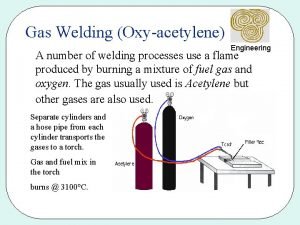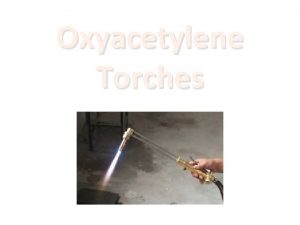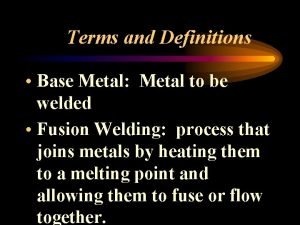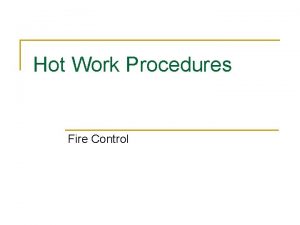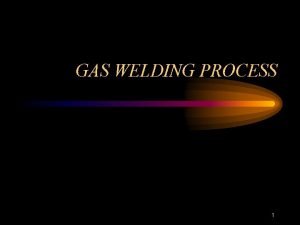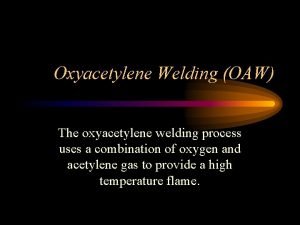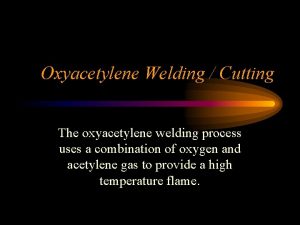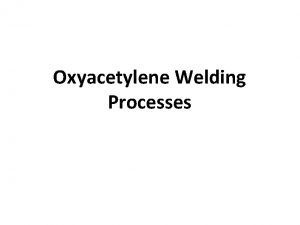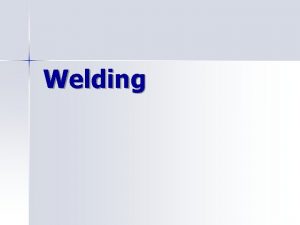LECTURE TWENTY TWO OXYACETYLENE WELDING INTRODUCTION Oxyacetylene welding









- Slides: 9

LECTURE TWENTY TWO OXYACETYLENE WELDING

INTRODUCTION Oxyacetylene welding (OAW) is a fusion-welding process performed by a hightemperature flame from combustion of acetylene and oxygen. The flame is directed by a welding torch. A filler metal is sometimes added, and pressure is occasionally applied in OAW between the contacting part surfaces. A typical OAW operation is sketched in figure (22. 1). When filler metal is used, it is typically in the form of a rod with diameters ranging from 1. 6 to 9. 5 mm (1/16 3/8 in). Composition of the filler must be similar to that of the base metals. The filler is often coated with a flux that helps to clean the surfaces and prevent oxidation, thus creating a better weld joint.

Figure (22. 1)

Acetylene (C 2 H 2) is the most popular fuel among the OFW group because it is capable of higher temperatures than any of the others—up to 3480 C (6300 F). The flame in OAW is produced by the chemical reaction of acetylene and oxygen in two stages. The first stage is defined by the reaction. 22. 1 a The products of which are both combustible, which leads to the second-stage reaction 22. 1 b The two stages of combustion are visible in the oxyacetylene flame emitted from the torch. When the mixture of acetylene and oxygen is in the ratio 1: 1, as described in Eq. (22. 1), the resulting neutral flame is shown in Figure 22. 2. The first-stage reaction is seen as the inner core of the flame (which is bright white), while the second-stage reaction is exhibited by the outer envelope (which is nearly colorless but with tinges ranging from blue to orange). The maximum temperature of the flame is reached at the tip of the inner cone; the second-stage temperatures are somewhat below those of the inner cone

Figure (22. 2)

During welding, the outer envelope spreads out and covers the work surfaces being joined, thus shielding them from the surrounding atmosphere. Total heat liberated during the two stages of combustion is 55 x 106 J/m 3 (1470 Btu/ft 3) of acetylene. However, because of the temperature distribution in the flame, the way in which the flame spreads over the work surface, and losses to the air, power densities and heat transfer factors in oxyacetylene welding are relatively low; f 1 = 0. 10 to 0. 30.

EXAMPLE

The combination of acetylene and oxygen is highly flammable, and the environment in which OAW is performed is therefore hazardous. Some of the dangers relate specifically to the acetylene. Pure C 2 H 2 is a colorless, odorless gas. For safety reasons, commercial acetylene is processed to have a characteristic garlic odor. One of the physical limitations of the gas is that it is unstable at pressures much above 1 atm (0. 1 MPa or 15 lb/in 2). Accordingly, acetylene storage cylinders are packed with a porous filler material (such as asbestos, balsa wood, and other materials) saturated with acetone (CH 3 COCH 3). Acetylene dissolves in liquid acetone; in fact, acetone dissolves about 25 times its own volume of acetylene, thus providing a relatively safe means of storing this welding gas.

The welder wears eye and skin protection (goggles, gloves, and protective clothing) as an additional safety precaution, and different screw threads are standard on the acetylene and oxygen cylinders and hoses to avoid accidental connection of the wrong gases. Proper maintenance of the equipment is imperative. OAW equipment is relatively inexpensive and portable. It is therefore an economical, versatile process that is well suited to low- quantity production and repair jobs. It is rarely used to weld sheet and plate stock thicker than 6. 4 mm (1/4 in) because of the advantages of arc welding in such applications. Although OAW can be mechanized, it is usually performed manually and is hence dependent on the skill of the welder to produce a highquality weld joint.
